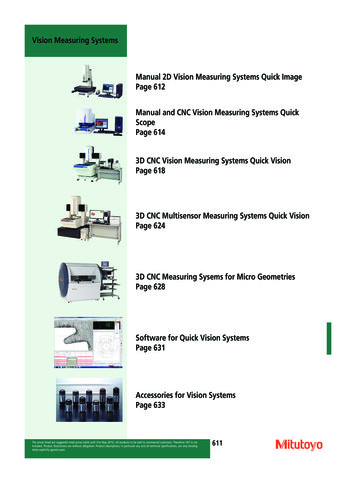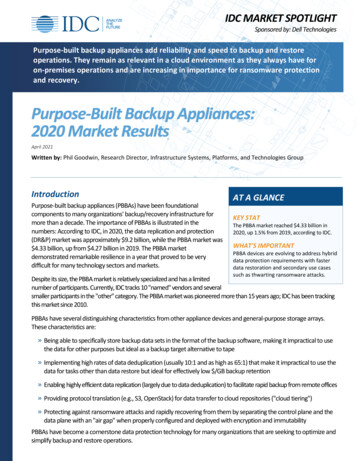
Transcription
May 2019Volume 99, Number 5Research SpotlightMeasuring the Digital EconomyBy Kevin Barefoot, Dave Curtis, William A. Jolliff, Jessica R. Nicholson, and Robert OmohundroIn April 2019, the Bureau of Economic Analysis (BEA) released updated measures of the digitaleconomy’s contributions to the overall U.S. economy. The measures include estimates of digitaleconomy gross output, value added, employment, and compensation for the period from 1997 to2017. The new estimates rely on the same methodology for measuring the digital economy asthose used for the initial estimates BEA published in March 2018. The April 2019 updateincorporated underlying data revised during the 2018 comprehensive update of the IndustryEconomic Accounts and expanded the time series.The March 2018 and April 2019 estimates are BEA’s initial efforts to lay the foundation for adigital economy satellite account and are the first set of estimates within the framework of thenational accounts. Conceptually, a digital economy satellite account should include all goods andservices related to the digital economy. However, BEA’s measures published to date are based ongoods and services that are primarily digital. BEA is researching data and methods to overcomethe challenges of measuring “partially digital” goods and services to expand the coverage of thedigital economy measures later in 2019.The updated estimates show the digital economy accounted for 6.9 percent ( 1,351.3 billion) ofcurrent-dollar gross domestic product (GDP) in 2017, up from 5.9 percent in 1997. Digitaleconomy real value added grew at an average annual rate of 9.9 percent per year from 1998 to2017, compared to 2.3 percent growth in the overall economy.BEA developed the digital economy estimates with support from the Commerce Department’sNational Telecommunications and Information Administration.–1–
MethodologyBEA prepared these statistics within the supply-use framework, following methodology used inthe production of BEA satellite accounts, including those on travel and tourism, arts and culturalproduction, and outdoor recreation.1The estimation process included three main steps:1. Developing a conceptual definition of the digital economy;2. Identifying goods and services within the supply-use framework relevant for measuring thedigital economy defined in the first step; and3. Using the supply-use framework to identify the industries responsible for producing thesegoods and services, and estimate the output, value added, employment, compensation andother variables associated with this activity.During the second step of this process, BEA reviewed the detailed goods and services categoriesfrom the supply-use framework to identify digital economy goods and services.2 Some goods andservices categories include a mix of both digital and nondigital goods and services. For example,the goods category electronic toys and games, including home video games (excluding cartridges,disks, and tapes) includes both digital video games and nondigital electronic toys. Conceptually,measures of the digital economy should include digital video games; however, due to data andresource constraints, the estimates presented here include the goods and services categories thatBEA considers primarily digital.Defining the digital economyThe digital economy is characterized by the rapidly changing nature of technology. Ideally, thedefinition of the digital economy would allow for the changing nature of what it encompasses overtime. Recognizing the large overlap between the information and communications technology(ICT) sector and the digital economy, BEA used its ICT sector as the starting point for measuringthe digital economy.3 To aid with identifying additional digital economy goods and services toinclude in the estimates, BEA relied on analyst expertise and existing digital economy literatureand statistics, including work from the Organisation for Economic Co-operation and Development(OECD).4 BEA includes in the digital economy: (1) the digital-enabling infrastructure needed for acomputer network to exist and operate, (2) the digital transactions that take place using thatsystem (“e-commerce”), and (3) the content that digital economy users create and access (“digitalmedia”).Identifying digital economy goods and servicesUsing this definition and the existing detailed data from the supply-use tables (SUTs), BEAidentified goods and services for inclusion in the digital economy estimates. BEA classifies data inthe SUTs using a framework that includes about 5,000 categories of goods and services based onthe North American Industrial Classification System (NAICS).–2–
BEA Methodology for Estimating Supply-Use TablesThe SUTs are an integral and essential element of the U.S. economic accounts. First, they are the building blocks forother economic accounts. Prominent among these are BEA’s National Income and Product Accounts (NIPAs), whichfeature the estimates of expenditure-based GDP. Second, the SUTs show how industries interact; specifically, theyshow how industries provide input to, and use output from, each other to produce GDP. They are a complete,balanced set of economic statistics, and they present a full accounting of industry and final-use transactions.The core of the SUTs consists of two basic national-accounting tables—a “supply“ table and a “use“ table. Thesupply table shows the commodities that are available for domestic consumption. The use table shows the inputsto industry production (intermediate inputs) and the commodities that final users consume. The use table is themost frequently requested table because of its applications to the estimates of GDP.BEA uses NAICS to classify industries. The United States, Canada, and Mexico jointly developed this classificationsystem with the aim of improving the comparability of their economic statistics. NAICS classifies industries basedon their production processes. The NAICS codes comprise six digits, which reading from left to right, indicate thegeneral sector down to a detailed industry.The U.S. statistical system does not currently have a separate classification system for commodities, which aregroups of similar products defined by the characteristics of the product (commodity) itself rather than by theproduction process. At present, BEA uses a commodity classification system to assign each commodity the code ofthe industry in which the commodity is the primary product. The foundation for this commodity classificationsystem is the six-digit NAICS code.BEA prepares benchmark SUTs roughly every 5 years based on the highest quality source data, notably the U.S.Census Bureau Economic Census. Largely because of their rich source data, the benchmark SUTs are the mostimportant statistical source of information for comprehensive updates of the NIPAs and are widely used by otherstatistical agencies. BEA released the most recent benchmark SUTs in 2018. These accounts cover 2012 and use the2012 NAICS for classification.BEA selected over 200 goods and services categories for inclusion in the digital economyestimates. The Appendix of the March 2018 working paper “Defining and Measuring the DigitalEconomy” lists all the goods and services included in the estimates. The goods and services BEAincluded in the estimates are only a subset of all the goods and services identified in theconceptual definition of the digital economy. As noted in the introduction, some NAICS-basedgoods and services categories include digital goods and services as well as nondigital goods andservices, or they are only “partially digital.” While BEA’s conceptual definition of the digitaleconomy includes all digital goods and services, BEA included only primarily digital goods andservices categories in the estimates.These estimates serve as the base for future estimates that will also include partially digital goodsand services. Including the latter requires additional data and research to split out the portion ofthe commodity value that is in scope for the digital economy. The last section of this researchnotes some of the efforts related to measuring partially digital goods and services.Digital-enabling infrastructureDigital-enabling infrastructure is comprised of the basic physical materials and organizationalarrangements that support the existence and use of computer networks and the digital economy.Table A describes the sub-components included in digital-enabling infrastructure and indicatesBEA’s coverage of the sub-component in the current digital economy estimates.–3–
Table A. Digital-Enabling Infrastructure in the Digital Economy EstimatesInfrastructure subcomponentComputer hardwareSoftwareTelecommunicationsequipment andservicesStructuresInternet of thingsSupport servicesSub-component descriptionThe manufactured physical elements that constitute a computer system, including,but not limited to, monitors, hard drives, semiconductors, wireless communicationsproducts, and audio and visual equipment products.The programs and other operating information used by devices such as personalcomputers and commercial servers, including both commercial software andsoftware developed in-house by firms for their own use.The equipment and services required for the digital transmission of informationover a distance by cable, telegraph, telephone, broadcasting, or satellite.The construction of buildings where digital economy producers create digitaleconomy goods or supply digital economy services. The structures category alsoincludes buildings that provide support services to digital products. This includesthe construction of data centers, semiconductor fabrication plants, the installationsof fiber optic cables, switches, repeaters, and so forth.Internet-enabled devices like appliances, machinery, and cars with embeddedhardware allowing them to communicate with each other and connect to theinternet.Services necessary for the function of digital infrastructure such as digital consultingservices and computer repair services.Currentlyincluded indigital economyestimates?Included almostcomprehensivelyIncluded almostcomprehensivelyIncluded almostcomprehensivelyNot yet included;part of ongoingworkNot yet included;part of ongoingworkIncluded almostcomprehensivelyFor both structures and internet of things (IoT) infrastructure, BEA does not currently have dataavailable to separate digital economy activity from all other activity. The case of IoT infrastructurepresents additional challenges. For example, the connectivity of an internet-enabled refrigeratormay allow the owner to track and purchase food items when they are running low or record usageof the appliance. However, the primary function of the refrigerator is to keep food cold, outputwhich BEA would not classify as being part of the digital economy.E-commerceBEA uses the term “e-commerce” to broadly describe all purchases and sales of goods and servicesthat occur over computer networks. E-commerce reflects the nature of a transaction for goods orservices. BEA considers e-commerce to include digitally ordered, digitally delivered, or platformenabled transactions.E-commerce output is generally measured as the wholesale or retail trade margin on “digitallyordered” goods and services sold over the internet or through some other electronic market. Themargin is equal to total revenue earned from online sales less the producer cost of the goods andservices. BEA included in the estimates the margin activity of electronic market establishmentsand some nonmargin activity as described in table B. For peer-to-peer (P2P) e-commerce, BEAcaptures the associated transactions, but is currently researching data and methodology to splitout the value of this output in scope for the digital economy.–4–
Table B. E-Commerce in the Digital Economy EstimatesEcommercesubcomponentSub-component descriptionBusinessto-business(B2B) ecommerceE-commerce that utilizes the internet or other electronic means toconduct either intrafirm or interfirm transactions of goods andservices by businesses to other businesses.Businesstoconsumer(B2C) ecommerceE-commerce that utilizes the internet or other electronic means toconduct the sale of goods and services by businesses to consumers,also known as retail e-commerce.Peer-topeer ecommerceThe “sharing economy,” or platform-enabled e-commerce, betweenconsumers that involves the exchange of goods and services for afee and facilitated through a digital application. Includes, but is notlimited to, accommodation rentals, transportation/ride-hailing,delivery and courier services, and consumer goods rental.Currently included in digital economyestimates?Includes the margin on B2B wholesaleactivity from electronic marketestablishments. Activity from other typesof establishments is not included. Alsoincludes nonmargin output for B2Belectronic markets.Includes the margin on B2C retail activityfrom electronic market establishments.Activity from other types ofestablishments is not included. Alsoincludes nonmargin retail trade fromelectronic auctions.Not separately identified from traditionalindustries; part of ongoing work toseparately identify within the account.Digital mediaIncreasingly, consumers forgo the physical purchase or rental of products like books, newspapers,music, and videos, opting instead to access these products online in a digital format. BEA definesdigital media as the content that people create, access, store, or view on digital devices.Table C describes how digital media is captured in the BEA digital economy estimates. Only directsale digital media is currently included. BEA’s national accounts data does capture the advertisingrevenue associated with free digital media sites; however, BEA does not currently have the dataneeded to identify what portion of advertising revenue is associated with these sites.Table C. Digital Media in the Digital Economy EstimatesDigitalmedia almediaBig dataSub-component descriptionBusinesses may sell digital products to consumers for a fee, either on an itemby-item basis or through a subscription service.Some companies offer digital media to consumers at no monetary cost, such asmuch of the content on YouTube or Facebook. Typically, businesses offeringthese services earn revenue by selling advertising space on the margins of thedigital product. This could also include peer-to-peer digital media produced byconsumers for peer consumption.Some companies generate large data sets as part of their regular operations.This could also include data on consumer preferences or behavior collectedthrough their use of digital media. Companies may earn revenue by selling thisinformation or leveraging it in other ways.–5–Currently included indigital economy estimates?Includes data streamingservices (both subscriptionand one-time purchases ofcontent), internet publishing,and internet broadcasting.Not separately identified; partof ongoing work.Not separately identified; partof ongoing work.
Identifying digital economy industries and preparing resultsBEA estimated nominal value added, output, compensation, and employment by industry for thedigital economy. After identifying the goods and services included in the digital economy, BEAidentified the industries that produce these goods and services using the supply table. Digitaleconomy gross output by industry represents the total value of in-scope gross output produced byeach industry across all digital economy goods and services. Value added for the digital economyis derived from the relationship between the industry output for the digital economy and totalindustry output. This means the ratio of intermediate consumption associated with the industryoutput for the digital economy is assumed to be the same as the ratio of total industryintermediate consumption to total industry output. Compensation and employment for the digitaleconomy are derived through the same procedure as value added. Specifically, the ratio of anindustry’s digital economy output to total output is applied to total employment andcompensation for the industry.BEA prepared price and quantity indexes for digital economy gross output and value added inthree steps. First, gross output indexes are derived by deflating each digital good and serviceproduced by an industry that is included as part of its gross output from the supply table. Second,BEA derived indexes for intermediate inputs by deflating all commodities from the use table thatare consumed by the industry as intermediate inputs in the production of digital goods andservices. Domestic and international sources of intermediate inputs are deflated separately byusing the import proportionality, or comparability, assumption. Third, BEA calculated indexes forvalue added by industry using the double-deflation method in which real value added is computedas the difference between real gross output and real intermediate inputs within a Fisher indexnumber framework.ResultsGross domestic product or value addedBEA estimates show the digital economy has been a bright spot in the U.S. economy. GDP is thevalue of the goods and services produced by the nation’s economy less the value of the goods andservices used up in production. GDP by industry, or value added, is a measure of an industry’scontribution to overall GDP. The digital economy accounted for 6.9 percent ( 1,351.3 billion) ofcurrent-dollar GDP ( 19,485.4 billion) in 2017, up from 5.9 percent in 1997. When compared withtraditional U.S. industries or sectors, the digital economy ranked just below professional, scientific,and technical services, which accounted for 7.4 percent ( 1,450.0 billion) of current-dollar GDP,and just above wholesale trade, which accounted for 6.0 percent ( 1,174.1 billion) of currentdollar GDP (chart 1).–6–
In 2017, digital economy real (inflation-adjusted) value added totaled 1,483.5 billion. BEAestimates show the digital economy was an engine of GDP growth throughout the period thesestatistics cover. From 1998 to 2017, real value added for the digital economy outpaced overallgrowth in the economy each year and mitigated the downturn in GDP during the recession in 2008and 2009 (chart 2). Excluding the recessionary years of 2008 and 2009, digital economy realvalue-added, year-over-year growth for this period was on average four times higher than totalGDP growth. Digital economy real value added grew at an average annual rate of 9.9 percent peryear from 1998 to 2017, compared to 2.3 percent growth in the overall economy.The relative strength of the digital economy led it to consistently contribute more to economicgrowth than its share of the economy. For example, in 2017, the digital economy accounted for just6.9 percent of the economy; however, real value-added growth of 8.3 percent in the digitaleconomy accounted for 25 percent, or 0.55 percentage point, of the total 2.2 percent growth inreal GDP.–7–
Over the entire 1998 to 2017 period, the digital economy experienced real value-added averageannual growth of 9.9 percent, compared to 2.3 percent for the total economy (chart 3). Within thedigital economy, the hardware component grew the fastest, with 18.4 percent average annualgrowth over the period. However, the growth rate in hardware varied notably between thebeginning and end of the period measured, ranging from 33.6 percent average annual growthbetween 1998 and 2007, down to 5.0 percent average annual growth from 2008 to 2017. Whilehardware grew the fastest over the period from 1998 to 2017, growth slowed to only 5.0 percentat an average annual rate in the most recent decade, the slowest of any digital economycomponent.Software and telecommunications exhibited slower average annual growth in the more recentyears, but to a much lesser extent, with average annual growth falling about 4 percentage pointsbetween the first and second decades in the time series for both components. For software,growth fell from 9.9 percent average annual growth from 1998 to 2007 to 5.8 percent from 2008–8–
to 2017, while telecommunications fell from 9.4 percent to 5.2 percent over the same period. Ecommerce and digital media exhibited more stable average annual growth (12.2 percent from1998 to 2007 and 11.1 percent from 2008 to 2017). Support services was the only component thatgrew faster during the second half of the period, with average annual growth of 7.0 percent from1998 to 2007 and 8.8 percent from 2008 to 2017.Overall, average annual growth of 18.9 percent in real value added of digital goods outpaceddigital services, which measured 7.7 percent. In the later decade, from 2008 to 2017, the averageannual growth rates for digital goods and digital services were more aligned at 8.0 percent and 6.9percent, respectively.From 1997 to 2017, digital economy current-dollar value added accounted for an average of 6.1percent of total U.S. current-dollar GDP each year (chart 4). The digital economy share of total GDPhas generally been rising, and in 2017, it accounted for 6.9 percent of the total economy, thehighest share over this time span. In this year, digital economy current-dollar value added totaled 1,351.3 billion.In current dollars, digital economy value added decreased in 2001; this was the only year in theseries in which year-over-year, current-dollar growth was negative. From 1998 to 2001, digitaleconomy prices rapidly decreased. The value-added price index fell by 7.3 percent from 2000 to2001, with the index for hardware falling by 33.9 percent as the quality of computer hardwareincreased rapidly.In 1997, digital-enabling infrastructure, or the hardware, software, telecommunications, andsupport services that comprise the digital economy, accounted for 95.0 percent ( 480.1 billion) ofdigital economy current-dollar total value added ( 505.3 billion) (chart 5). In 2017, digitalenabling infrastructure accounted for 1,143.4 billion (84.6 percent) of the total estimated 1,351.3 billion in digital economy current-dollar value added. E-commerce and digital mediagrew from accounting for just 5.0 percent ( 25.2 billion) of the digital economy to 15.4 percent( 207.8 billion) over the 20-year timespan.–9–
While e-commerce and digital media became a larger share of digital economy current-dollarvalue added, there were also shifts in the composition of the components that make up digitalenabling infrastructure. In 1997, telecommunications accounted for 40.7 percent ( 205.5 billion)of total digital economy current-dollar value added. By 2017, telecommunications current-dollarvalue added had grown to 339.6 billion, but its share of the overall digital economy had fallen to25.1 percent. Hardware declined in its total value and in its contribution to digital economycurrent-dollar value added, accounting for 19.8 percent ( 100.3 billion) of the total in 1997 andjust 7.1 percent ( 96.3 billion) in 2017. Support services and software, the other two componentsof digital-enabling infrastructure, contributed more to digital economy current-dollar value addedin 2017 compared to 1997, growing from 23.1 percent to 34.7 percent and 11.4 percent to 17.7percent, respectively.Gross outputGross output is a measure of sales or revenue from production for most industries. Real grossoutput for the digital economy grew at an annual rate of 6.3 percent from 1998 to 2017, fasterthan the total economy, which grew at an average annual rate of 2.1 percent. The compound effectof the faster output growth in the digital economy relative to the overall economy is clearly seenwhen output is indexed to a base year (chart 6). Since the end of the most recent recession, theoutput growth from the digital economy has continued to outpace the overall economy. Since2010, digital economy real gross output growth averaged 2.5 percent per year and outpacedaverage annual real gross output growth of 1.0 percent in the overall U.S. economy, widening thedistance between the gross output indexes displayed in chart 6.During this period of economic recovery, prices for digital economy goods and services decreasedat an average annual rate of 1.0 percent (chart 7). Prices for all goods and services in the economyincreased at an average annual rate of 1.6 percent.– 10 –
Although real output in the digital economy accelerated faster than real output for the economyoverall, the falling prices of digital goods and services caused current-dollar gross output growthin the digital economy and the overall economy to track much closer (chart 8). Digital economynominal gross output reached 2.05 trillion in 2017, totaling 6.0 percent of total U.S. nominalgross output.Employment and compensationIn 2017, the digital economy supported 5.1 million jobs, which accounted for 3.3 percent of totalU.S. employment (152.1 million jobs), comparable to the transportation and warehousing industry(chart 9). Employees working in the digital economy earned 132,223 in average annualcompensation compared to 68,506 average annual compensation per worker for the total U.S.economy.– 11 –
Next StepsBEA is working to expand the coverage of the digital economy estimates to include additional ecommerce activity and selected partially digital commodities. The feasibility of expanding thecoverage is conditional on data availability. BEA is also exploring data and methodologies toinclude activities of digital intermediaries, such as ride-hailing activity. At this time, cloudcomputing estimates are fully included in BEA digital economy estimates but are not a separateline item, like hardware or software. Some of the NAICS-based services categories include outputrelated to cloud computing services as well as unrelated output. BEA needs additional data toestimate the relevant portions to separately value clould computing in the digital economyestimates.BEA actively participates in OECD meetings on developing digital SUTs with the continued goal ofimplementing international guidance on measuring the digital economy. BEA will align its digitaleconomy measures to international standards to the extent possible. BEA is assessing thefeasibility of publishing a complete set of SUTs for the digital economy in late 2019.– 12 –
1. For more information on the methodology and satellite accounts, see “Measuring the Nation’s Economy: AnIndustry Perspective. A Primer on BEA’s Industry Accounts&rquo;. The industry accounts are one component ofthe U.S. economic accounts that provide information on the value and composition of output produced in theUnited States and on the types of income generated.2. BEA classifies goods and services using a system based on the North American Industrial Classification System.3. The BEA ICT sector consists of computer and electronic product manufacturing (excluding navigational,measuring, electromedical, and control instruments manufacturing); software publishers; broadcasting andtelecommunications; data processing, hosting, and related services; internet publishing and broadcasting andweb search portals; and computer systems design and related services. BEA’s definition is generally consistentwith the internationally accepted definition of the ICT sector used and developed by the statistical offices of theOrganisation for Economic Co-operation and Development and United Nations.4. For information on the OECD’s digital economy measurement work, see http://www.oecd.org/sti/ieconomy/.BEA also participates in the OECD working group on Measuring GDP in a Digitalized Economy.Survey of Current Businesswww.bea.gov/scbscb@bea.gov(301) 278-9004– 13 –
that occur over computer networks. E-commerce reflects the nature of a transaction for goods or services. BEA considers e-commerce to include digitally ordered, digitally delivered, or platform-enabled transactions. E-commerce output is generally measured as the wholesale or retail trade margin on "digitally











